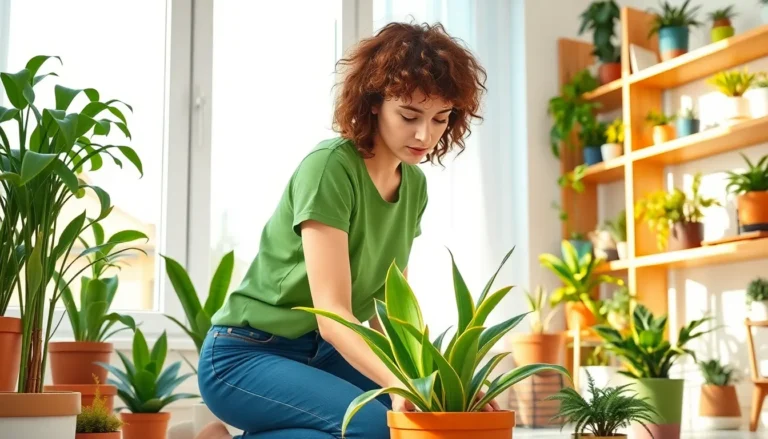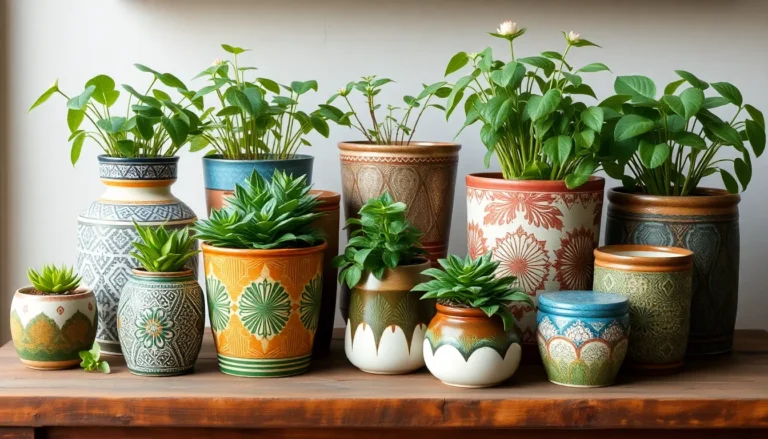Tropical house plants are like the vacation your home never knew it needed. Imagine lush greenery and vibrant colors transforming your living space into a mini rainforest. Not only do these plants boost your mood, but they also purify the air, making your home feel fresher than a morning breeze. Who wouldn’t want to live in a jungle paradise?
Table of Contents
ToggleOverview of Tropical Common House Plants
Tropical common house plants thrive in warm climates, making them ideal for indoor spaces. Varieties such as the peace lily and pothos add a lush look while requiring minimal care. They adapt well to varying light levels. Low-light varieties, like the snake plant, flourish even in dim areas.
Tropical plants also contribute valuable benefits to indoor environments. They improve air quality by filtering toxins and increasing humidity. Plants such as spider plants and rubber trees enhance the breathable atmosphere in homes. Research shows that indoor plants can heighten mood and reduce stress.
Common tropical plants offer diverse aesthetics and practical uses. Varieties like ZZ plants and monstera exhibit striking foliage that complements various decor styles. Colorful options like bromeliads bring vibrant hues to rooms, promoting a lively ambiance.
Care requirements of tropical plants vary, often including consistent watering and occasional fertilization. Grouping plants with similar needs simplifies maintenance. Regular misting can help maintain humidity levels in drier environments.
Many tropical plants possess notable resilience, often thriving despite occasional neglect. They adapt to various lighting conditions, demonstrating their versatility and appeal. This adaptability makes them suitable for a wide range of households.
A variety of tropical plants energizes living spaces, providing visual interest and health benefits. Whether enhancing decor or purifying air, tropical house plants play a vital role in creating inviting environments.
Benefits of Tropical Common House Plants
Tropical common house plants offer substantial benefits, enhancing indoor environments in various ways.
Air Purification
Air purification is a key advantage of tropical house plants. They actively filter airborne toxins, such as formaldehyde and benzene. Peace lilies and snake plants excel at cleaning air, making spaces healthier. Increased humidity from these plants also alleviates dryness, helping to combat respiratory issues. Studies confirm that indoor plants improve air quality significantly, contributing to overall well-being. Opting for a variety of these plants maximizes air purification effects, creating a fresher atmosphere in homes.
Aesthetic Appeal
Aesthetic appeal is another remarkable benefit of tropical common house plants. Striking foliage and vibrant colors elevate any decor style. Rubber trees, pothos, and spider plants add visual interest and texture to indoor spaces. With their lush appearance, these plants create a warm, inviting ambiance. Each plant has unique characteristics, catering to diverse aesthetic preferences. Grouping different plants together enhances overall beauty, while individual plants can serve as captivating focal points. Incorporating tropical plants transforms living areas into tranquil retreats, promoting relaxation and enjoyment.
Popular Tropical Common House Plants
Tropical common house plants enhance living spaces with their vivid colors and unique textures. Many of these plants thrive indoors, making them beloved choices for plant enthusiasts.
Monstera Deliciosa
Monstera Deliciosa, known for its large, split leaves, makes a striking addition to any room. This plant thrives in indirect sunlight and appreciates humidity, making it ideal for bathrooms or kitchens. Minimal care is required; watering when the top inch of soil dries out suffices. Monstera can grow several feet tall, serving as an impressive focal point. It’s important to note this plant purifies the air by filtering toxins, thus promoting a healthier environment.
Pothos
Pothos is a resilient plant known for its trailing vines and heart-shaped leaves. This plant adapts effortlessly to a range of lighting conditions, from low light to bright indirect sunlight. Regular watering is necessary, though overwatering should be avoided. Use Pothos’ natural climbing abilities to create beautiful vertical displays. In addition to aesthetics, Pothos contributes to air purification, helping reduce indoor pollutants.
Snake Plant
Snake Plant thrives on neglect, making it an excellent choice for busy households. Known for its tall, upright leaves, this plant tolerates low light and infrequent watering, providing a low-maintenance option. Snake Plant also enhances indoor air quality by absorbing toxins and releasing oxygen at night. Its architectural form creates a dramatic effect in any setting. As an adaptable plant, it suits various decor styles wonderfully.
Peace Lily
Peace Lily is celebrated for its elegant white blooms and glossy green leaves. This plant prefers low to medium light and thrives in humid environments. Watering occurs when the soil feels dry; this plant shows clear signs when it’s thirsty. Peace Lily actively purifies the air by filtering harmful substances, enhancing indoor air quality significantly. Its beautiful flowers and lush foliage add a serene touch to any room, making it a popular choice among plant lovers.
Tips for Caring for Tropical Common House Plants
Caring for tropical common house plants requires attention to light, water, and nutrients. These essential elements foster plant health and longevity.
Light Requirements
Most tropical house plants thrive in bright, indirect light. Positioning them near a window allows for optimal growth. Some plants, like snake plants, tolerate low light conditions effectively. Ensure that no direct sunlight scorches the leaves, as this can cause damage. Adjusting their location based on seasonal light changes helps maintain healthy foliage. Observing plants for signs of inadequate light, such as leggy growth, prompts timely repositioning.
Watering Guidelines
Watering practices influence the health of tropical plants significantly. Soil should remain consistently moist but not waterlogged. Checking the top inch of soil allows for better assessment of moisture levels. During warmer months, tropical plants generally require more frequent watering. Conversely, reducing watering during winter months is essential to avoid root rot. Ensuring proper drainage in pots prevents excess water buildup, promoting healthier root systems.
Fertilization
Fertilization supports tropical plants in achieving robust growth. Using a balanced liquid fertilizer during the growing season enhances nutrient uptake. Applying fertilizer every four to six weeks ensures plants receive vital nutrients. Avoid fertilizing during the dormant winter months to prevent stress. Observing the growth patterns of plants helps identify if additional nutrients are needed. Investing in high-quality fertilizers provides essential micronutrients for optimal plant health.
Tropical common house plants bring a unique blend of beauty and health benefits to any home. Their vibrant colors and striking foliage not only enhance decor but also create a soothing atmosphere. With their ability to purify the air and improve humidity levels, these plants are invaluable companions for anyone looking to elevate their living space.
Whether it’s the resilient snake plant or the elegant peace lily, each variety offers distinct advantages. By understanding their care requirements, plant enthusiasts can enjoy a thriving indoor jungle that contributes to overall well-being. Embracing tropical house plants can transform a home into a lush retreat, making it a welcoming haven for relaxation and enjoyment.






